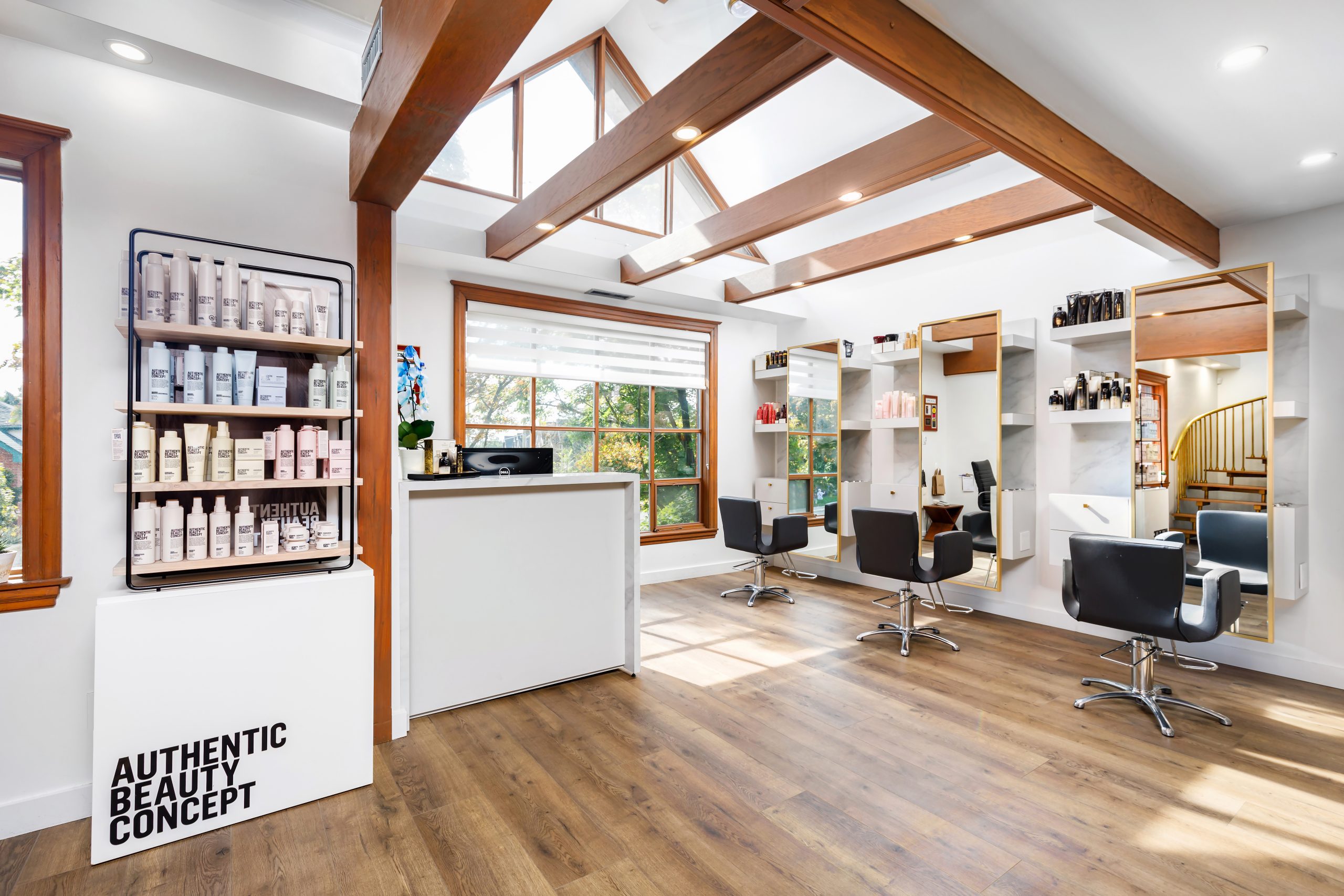How to Use Lighting to Enhance Your Salon Atmosphere for Ultimate Function

Design by Fiore Design Group: Trichology Boutique
When designing a salon, lighting is one of the most crucial elements for creating a functional and inviting atmosphere. The proper lighting can elevate your client’s experience and improve the accuracy of hair coloring. From the type of lighting fixtures to their placement and the color temperature, every aspect of lighting plays a role in shaping the mood and function of your salon space.
Layering Lighting Fixtures for Maximum Impact
Layering different types of lighting is essential to achieving a well-lit salon that balances functionality and atmosphere. Three primary lighting types are to consider: ambient, task, and accent.
Ambient Lighting
Your salon’s general lighting provides the overall illumination. Overhead fixtures like recessed or pendant lights offer broad coverage and help ensure clients feel comfortable. A well-lit space will feel welcoming, so the ambient lighting is evenly distributed to avoid shadows or dark corners.
Task Lighting
Task lighting is more focused and essential for work areas like styling stations, shampoo areas, and manicure tables. Adjustable task lights are perfect for styling stations because they provide direct illumination, allowing stylists to see hair color, texture, and fine details. LED mirrors or lighted vanity mirrors are a popular choice for precise lighting.
Accent Lighting
Accent lighting can highlight specific salon areas, such as product displays, art, or architectural features, for added ambiance and visual interest. Wall sconces, strip lighting along shelves, or small spotlights create a luxurious feel without overpowering the space. Accent lighting also helps guide clients’ attention and enhances the overall aesthetic.
Strategic Placement of Lights
Where you place your lighting fixtures matters as much as the type of light you choose. Proper placement ensures functionality and creates a dynamic atmosphere.
Styling Stations
Position lighting around or above mirrors to reduce shadows on clients’ faces and hair. A combination of task lights and LED-backlit mirrors provides even illumination and ensures stylists can work with precision.
 Swing has a minimal and clean character that can adapt to different salon styles. This wall mirror has LED lighting, a stainless steel top, Pral or wood, and a blow-dryer holder.
Swing has a minimal and clean character that can adapt to different salon styles. This wall mirror has LED lighting, a stainless steel top, Pral or wood, and a blow-dryer holder.
Reception Area
Your salon’s first impression begins here. Use warm and welcoming ambient lighting and stylish accent lights, such as chandeliers or pendant lights, to create a luxurious and inviting entrance.
Shampoo Area
This area should be more tranquil, so consider using softer, dimmable lights to create a calming, spa-like environment. Recessed lighting or low-hanging fixtures that don’t glare directly into clients’ eyes are ideal for this space.
Color Stations
Proper lighting is critical for accurate color application. Natural daylight is the best option, but in its absence, full-spectrum LED lights with a color rendering index (CRI) of 90 or above are a great choice, as they mimic natural light and reduce the chance of color distortion.
Choosing the Right Light Color
The color of light, measured in Kelvin (K), plays a crucial role in determining the mood of your salon. Light color ranges from warm (yellow tones) to cool (blue tones), and the temperature you select should match the purpose of each area.
Warm Lighting (2,700K – 3,000K)
Soft, warm light works well in areas like the reception or waiting lounge where you want to create a relaxed, welcoming atmosphere. Warm lighting can make your salon feel cozy and inviting.
Neutral Lighting (3,500K – 4,000K)
This lighting is excellent for task areas like styling stations, as it’s bright enough to ensure accuracy without being too harsh. Neutral light closely resembles daylight, making it ideal for ensuring that hair colors appear accurate to tone and aren’t swayed to a warm or cool tone.
Cool Lighting (5,000K and above)
Cool lighting is often used in product display areas to create a modern, clean look. While it’s less flattering on skin tones, it works well in areas where crisp, bright light is required, such as retail sections or product shelves.
Energy Efficiency and Sustainability
LED lighting is a must for any modern salon. LEDs are energy-efficient, reduce electricity bills, and have a longer lifespan than traditional incandescent or fluorescent bulbs. LED lights offer versatility, coming in various color temperatures and dimmable options, making them perfect for salons where lighting needs vary throughout the day. LEDs emit less heat, keeping your salon comfortable for staff and clients.
Utilizing Natural Light
Maximize natural light by styling stations near windows or using skylights whenever possible. Natural light is flattering for clients and helps create a more uplifting atmosphere. However, balance it with other lighting to avoid glare and shadows, especially on cloudy days or in the evening.
Lighting can dramatically influence how your salon looks, feels, and functions. You can create a beautiful and efficient environment by layering different types of lighting, strategically placing fixtures, and choosing the right color temperature. For the ultimate salon environment, focus on the details—use lighting that complements your salon’s aesthetic while providing the practicality needed for day-to-day operations. The right combination of lighting elements will elevate your salon to new heights, ensuring that clients leave feeling pampered and impressed.



